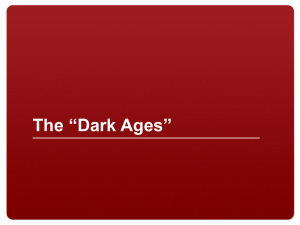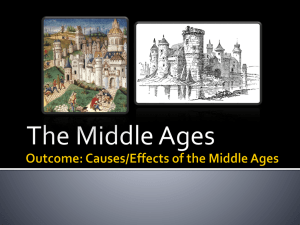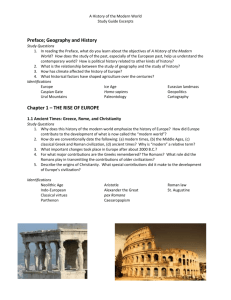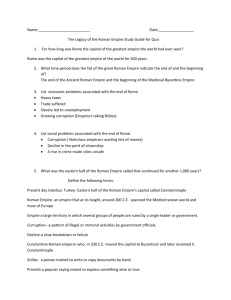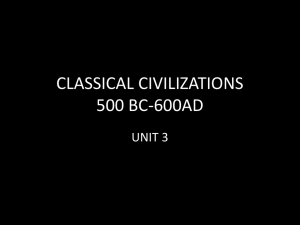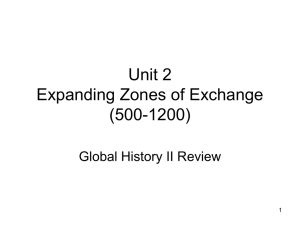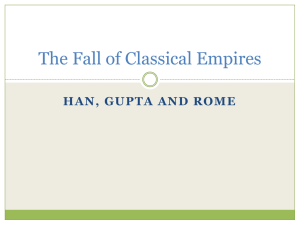QUESTIONS ABOUT THE VIDEO THE MIDDLE AGES IN 3 ½
advertisement
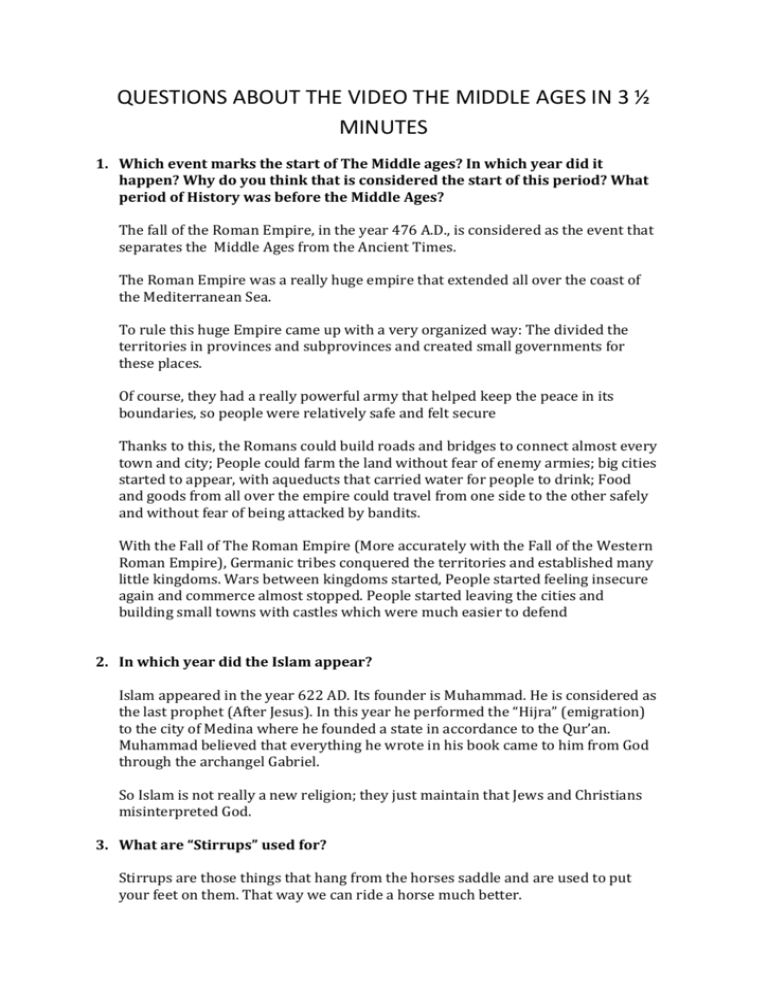
QUESTIONS ABOUT THE VIDEO THE MIDDLE AGES IN 3 ½ MINUTES 1. Which event marks the start of The Middle ages? In which year did it happen? Why do you think that is considered the start of this period? What period of History was before the Middle Ages? The fall of the Roman Empire, in the year 476 A.D., is considered as the event that separates the Middle Ages from the Ancient Times. The Roman Empire was a really huge empire that extended all over the coast of the Mediterranean Sea. To rule this huge Empire came up with a very organized way: The divided the territories in provinces and subprovinces and created small governments for these places. Of course, they had a really powerful army that helped keep the peace in its boundaries, so people were relatively safe and felt secure Thanks to this, the Romans could build roads and bridges to connect almost every town and city; People could farm the land without fear of enemy armies; big cities started to appear, with aqueducts that carried water for people to drink; Food and goods from all over the empire could travel from one side to the other safely and without fear of being attacked by bandits. With the Fall of The Roman Empire (More accurately with the Fall of the Western Roman Empire), Germanic tribes conquered the territories and established many little kingdoms. Wars between kingdoms started, People started feeling insecure again and commerce almost stopped. People started leaving the cities and building small towns with castles which were much easier to defend 2. In which year did the Islam appear? Islam appeared in the year 622 AD. Its founder is Muhammad. He is considered as the last prophet (After Jesus). In this year he performed the “Hijra” (emigration) to the city of Medina where he founded a state in accordance to the Qur’an. Muhammad believed that everything he wrote in his book came to him from God through the archangel Gabriel. So Islam is not really a new religion; they just maintain that Jews and Christians misinterpreted God. 3. What are “Stirrups” used for? Stirrups are those things that hang from the horses saddle and are used to put your feet on them. That way we can ride a horse much better. 4. Who are the Vikings and where do they come from? What was their way of life like? Vikings were Germanic tribes from the North of Europe (Norway, Denmark and Sweden mainly). Vikings were great sailors and seamen, so from the 8TH to 11TH centuries they madde a living from attacking towns and cities all over Europe. Even in Sicily! 5. Why is the king Charlemagne so important for education in Europe? He was the king of the Franks, a Germanic tribe that conquered modern France and the north of modern Spain. He is considered the first Roman emperor after the Fall the Roman Empire, because he managed to establish a big, powerful and organized empire. He is important to European Education because he ordered that schools were opened at churches and monasteries so that the children could start learning. 6. Write at least two subjects that were taught to children during the Middle Ages and that you also study at school now. During the Middle Ages, children curriculum was divided into two: Trivium (grammar, logic and rhetoric) and Quadrivium (arithmetic, geometry, music and astronomy). And of course Bible studies. 7. Why were peoples from the East ahead of Europe in Education? The Islamic prophet Muhammad founded the first madrassa (school) at Medina in the year 622, which is around 250 years before Charlemagne did. In these schools, children learnt reading, writing, first-aids, athletics and martial arts, horse-riding… and of course, The Qur’an. 8. What did Al-Khwarizmi introduced in Europe? Why are they so important? Al-Khwarizmi copied from the Indians (from India) the way in which they wrote the numbers, and wrote a book that then was translated to Latin and spread all over Europe. Everywhere, these Indian numerals were adopted instead of the Roman numerals. Nowadays, Indian Numerals are the most popular way in the world of writing numbers. Their main advantage is the simplicity in which they work, which we call decimal positional number system (position of a number also counts when reading and writing a number). 9. What are chemical elements, smallpox, measles, kerosene and optometry? Do you think these things are still important for us in the present? Chemical elements: Elementos químicos. Before Jabir Ibn Hayyan, everyone believed that the elements were fire, wind, earth and water. He discovered that elements were things made up of one substance, and classified the ones he found into spirits (sulphur), metals and non-malleable (stones) substances. He was not totally right but it was a big step. Smallpox & Measles: Varicela y Sarampión. Al-Razi discovered that these two deseases were totally different, even if they looked the same. He also described their symptoms and cures. His book was translated to Latin and spread all over Europe. Kerosene: Queroseno. Al-Razi also discovered Kerosene. Thanks to him, people now had a substance that when burnt gave a much brighter light than wood or other things, and lasted for longer. People now could see much better during the night. Optometry: Optometria. Al-Haytham was the first person to establish scientifically how sight works: When an object is illuminated, it issues light from each of it’s and color along straight lines that enter the eye; And that the eye had to have a cone that filtered all those rays and make sense of the image. 10. What is a “Canon of Medicine”? Who wrote it? A “canon of medicine” is an “Encyclopaedia of medicine”. It was finished by Avicenna in the year 1025. He presents a summary of everything known in medicine at that time, and was used during the whole Middle Ages as the book of reference for all medics in Islam and Christianity. 11. What are the Crusades? When did they start? In the year 1093 the Pope Urban II proclaimed the First Crusade. The objective was to free holy places in and near Jerusalem from the Muslims. The crusades were a long series of military campaigns that lasted until the year 1291. 12. Why was the translation of Aristotle’s work first to Arab, and then to Latin so important? Aristotle invented the first “Scientific Method”. This method says that scientists should use Logic and experiments to discover the Natural Laws. Before Aristotle, “scientists” didn’t do experiments, they just looked at things and used only their logic to understand nature. By doing experiments, scientists obtain good reliable information before they use their logic to figure out what is going on. So by translating Aristotle first to Arab and then to Latin, good scientific work was made possible, and science advanced faster. 13. Which were the three first universities in Europe founded? How long after the first Islamic university was founded was that? The first three were Bologna (1088), Paris (1150) and Oxford (1167). The first Islamic University was Al-Qarawiyyin, founded in the year 859 in Fes (Morocco); more than 200 years before than Bologna. 14. What are windmills, spectacles, compasses and spinning wheels used for? What progress do they make? Windmill: Molino de viento. It allowed to crush grain into flour using the force of the wind, which made it much easier. Spectacles: Anteojos. The first type of glasses. During the whole History people have had problems with their sight. Thanks to the invention of spectacles this problem was “more or less” solved: They weren’t as good as the ones we have now, and they were really expensive. Compass: Brújula. Thanks to the compass, maps could be done more accurately, and people could follow them more accurately. This means that journeys by land and sea could be much safer and easy. Spinning wheels: Rueca. When the cotton is collected, it has to be turned into strings, so that then it can be used to make clothes. Until the invention of the pinning wheel people had to do this by hand, which is very difficult, slow and tiring. Thanks to the spinning wheel this could be done now just by turning a lever and it could be done sitting down. 15. What is the Silk Road? What was it used for? They silk route was a route that connected Europe with places as far as China. Along this route food and goods went from one side of the world to the other. But also news were carried: Merchants and travellers would tell each other where they came from and what was happening there, so the Silk Road was also the way culture was spread. Marco Polo was a very famous merchant traveller from the 13th century that wrote a book about his journeys along the Silk Road and all the countries he visited. 16. When did the Plague start? In the year 1347 there was an outbreak of bubonic plague that killed around a third of the human population. It originated in China and it is believed to have arrived to Italy by boat, from where it spread all through Europe. 17. What is a printing press? What is it used for? Who invented it and when? Why was its invention so important for education and culture? Prensa. It was invented in China around the 11th Century. Later on, around the year 1439, Gutenberg invented his own version of a printing press. The traditional way of making a book was…writing it. This process was very slow, and required a lot of training, time and effort, and obviously knowing how to read and write. This meant that the only people who made books were monks at monasteries. With the press, copying a page was as easy as putting ink on a carved wooden plank and pressing it against papers. But not only this, carving a plank of wood with all the letters, one by one, is also quite difficult, so Gutenberg had even a better idea. Instead of making whole pages in wood; he did a lot of individual letters, being able to fit them in place to make the page. Thanks to him, more books were printed, at less price, and people could afford to buy them, so in the end mor people started to learn how to write and read. 18. What event marks the end of the Middle Ages? When did it happen? Why do you think that is considered as the end of this period? What period of History comes next? In the year 1492, Christopher Columbus discovered America. There was a whole new continent (two in fact) to discover, conquer and exploit. These started a new age of journeys to discover new and exotic lands, open trade routes and of adventures. Little by little contact was remade between distant countries, as it had been during the times of the Roman Empire. Bigger and bigger cities were being built and thanks to science many things become easier and faster to do. The Middle Ages are also called sometimes the Dark Ages. Even if this is not 100% true, during the Middle Ages, Europe, economy and intellectual advancements suffered a regression that now was being solved. The next period in History are the Modern Times, which start with the Renaissance in Italy.
